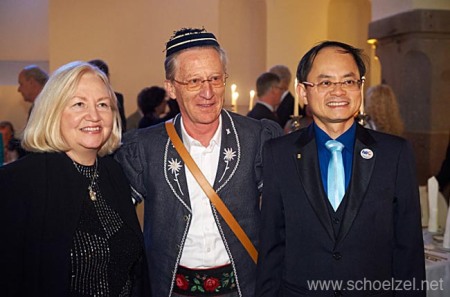Following what happened last year, FDI Mid Year Council and Chairs of Committees Meetings took place out of Genève. If last year the city chosen was Lisbon, this year was Potsdam, in Germany. ERO (European Regional Organisation of the World Dental Federation) plenary session was held immediately after.
Wikipedia: “Schloss Cecilienhof is a palace in the northern part of the Neuer Garten park in Potsdam, Germany, close to the Jungfernsee lake. It has been part of the Palaces and Parks of Potsdam and Berlin UNESCO World Heritage Site since 1990.
Cecilienhof was the last palace built by the Hohenzollern family. Emperor Wilhelm II of Germany had it erected for his son, Crown Prince Wilhelm of Germany, and the crown prince’s wife Duchess Cecilie of Mecklenburg-Schwerin. The house was designed by Paul Schultze-Naumburg to look like an English Tudor country house[1] and was built between 1914 and 1917. The interior was furnished according to plans by Paul Troost, who originally had designed steamship décors.
The brick and oak timberframe building, including six courtyards and 55 carved brick chimney tops, should have been completed in 1915, but construction was delayed due to the outbreak of World War I and Crown Prince Wilhelm and Cecilie could not move in until August 1917. Wilhelm followed his father into exile one year later, while Cecilie stayed at the palace until she fled from the approaching Red Army in February 1945.
Cecilienhof was the location of the Potsdam Conference between 17 July and 2 August 1945. The rooms had been largely refurnished to match the taste of the participants. Winston Churchill, later Clement Attlee, Joseph Stalin and Harry S. Truman met at the round table in the great hall. On 26 July 1945, Churchill and Truman issued the Potsdam Declaration defining the terms for Japanese surrender, while Truman had already given order to prepare the atomic bombing of Hiroshima and Nagasaki.Today Cecilienhof is a museum as well as a hotel. Queen Elizabeth II visited Cecilienhof on 3 November 2004. On 30 May 2007, the palace was used for the G8 foreign ministers summit.”
It was, once again, a fruitful council meeting as well as the committees meetings. Thanks to all colleagues that gave some of their time and knowledge to this common aim that links us all: the future of dental medicine and Oral Health worldwide.

Emmanuel Chevron (associate director for Business Development & Corporate Relations), Jean-Luc Eiselé (FDI executive director) and Jaime Edelson (FDI councillor).

Peter Engel, president of the German Dental Association BZÄK. A special recognition to the BZAK, and Peter Engel for all the collaboration!
















 Posted by Orlando Monteiro da Silva
Posted by Orlando Monteiro da Silva  Under the invitation of Paul Polman, Unilever CEO, I participated at a roundtable event in London to discuss the Unilever Sustainable Living Plan.
Under the invitation of Paul Polman, Unilever CEO, I participated at a roundtable event in London to discuss the Unilever Sustainable Living Plan.
